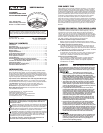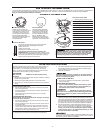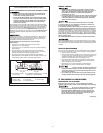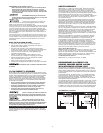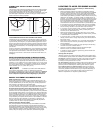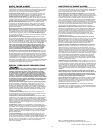
F
OLLOW THESE INSTALLATION STEPS, Continued
S
PECIAL REQUIREMENTS FOR INTERCONNECTED SMOKE ALARMS
•
Failure to meet any of the requirements for interconnecting
S
moke Alarms could damage the units, and cause them to
m
alfunction, removing your protection.
•
A
C and AC/DC Smoke Alarms can be interconnected. Under
A
C power, all units will alarm when one senses smoke. When
power is interrupted, only the AC/DC units in the series will
c
ontinue to send and receive signals. AC powered Smoke
A
larms will not operate.
I
nterconnected units can provide earlier warning of fire than stand-alone
units, especially if a fire starts in a remote area of the home. If any Smoke
A
larm in the series senses smoke, all units will alarm. This Smoke Alarm
c
an be interconnected with
F
irst Alert
®
S
moke Alarm Models SA4120,
SA4121B, SA100B, SC9120B and BRK Electronics
®
Smoke Alarm
M
odels 100S, 4120 series, 9120 series, 7010 series;
B
RK Electronics
®
H
eat Alarm Models HD6135F, HD6135FB; Smoke/CO Alarm Model
SC6120B.
I
nterconnect units within a single family residence only. Otherwise all
h
ouseholds will experience unwanted alarms when you test any unit
in the series. Interconnected units will only work if they are wired to
c
ompatible units and all requirements are met.
I
nterconnected units must meet ALL of the following
r
equirements:
•
A maximum of 18 units total may be interconnected
(Maximum of 12 Smoke Alarms).
•
The same fuse or circuit breaker must power all interconnected
S
moke Alarms.
• The total length of wire interconnecting the units should be
l
ess than 1000 feet (305 meters). This type of wire is commonly
available at Hardware and Electrical Supply stores.
•
All wiring must conform to all local electrical codes and the
N
ational Electrical Code (NFPA 70). Refer to NFPA
72 and/or your
local building code for further connection requirements.
}
}
A. Unswitched 120VAC
60 Hz source
B. To additional units; Maximum = 18 total
(Maximum 12 Smoke Alarms)
1. Smoke Alarm
2. Ceiling or Wall
3. Power Connector
4. Wire Nut
5. Junction Box
6. Neutral Wire (Wht)
7. Interconnect Wire
8. Hot Wire (Blk)
3
W
EEKLY TESTING
• NEVER use an open flame of any kind to test this Smoke
Alarm. You might accidentally damage or set fire it unit or to
y
our home. The built-in test switch accurately tests the
Smoke Alarm’s operation as required by Underwriters
L
aboratories, Inc. (UL).
• Do not look directly at or touch the lens while the strobe light
i
s flashing. Doing so can hurt your eyes or burn your fingers.
I
f the strobe light does not flash during testing, the Smoke
Alarm should be replaced.
D
o not stand too close to the unit when the alarm is sounding.
I
t is loud to wake you in an emergency. Exposure to the horn at
close range may harm your hearing.
I
t is important to test this Smoke Alarm every week to make sure it
i
s working properly. Using the test button is the recommended way
to test this Smoke Alarm.
Press and hold the test button on the cover
u
ntil the alarm sounds (it may continue alarming briefly after you release
t
he button). If the Smoke Alarm does not sound make sure it is receiving
power and test it again. If it still does not alarm, replace it immediately.
D
uring testing, you will hear a loud, repeating horn pattern: 3 beeps,
p
ause, 3 beeps, pause.
The strobe light should flash every time you test the Smoke Alarm.
W
hen testing Smoke Alarms in an interconnected series, you must test
each unit individually. Make sure all units alarm when each one is tested.
T
he strobe lights on all units should flash as each individual Smoke Alarm
i
s tested.
REGULAR MAINTENANCE
This unit has been designed to be as maintenance free as possible, but
t
here are a few simple things you must do to keep it working properly.
•
Test it at least once a week.
•
Clean the Smoke Alarm at least once a month; gently vacuum off
a
ny dust using your household vacuum’s soft brush attachment,
and test the Smoke Alarm after cleaning. Never use water,
cleaners or solvents since they may damage the unit.
• If the Smoke Alarm becomes contaminated by excessive dirt,
dust and/or grime, and cannot be cleaned to avoid unwanted
alarms, replace the unit immediately.
• Relocate the unit if it sounds frequent unwanted alarms.
See “Locations to Avoid For Smoke Alarms” for details.
• If the strobe light is loose or broken, the entire unit should be
replaced immediately. Never remove the strobe light lens for
any reason. Doing so can permanently damage the unit and
will void your warranty.
• Do no
t paint over the unit. Paint may clog the openings to the
sensing chamber and prevent the unit from operating properly.
IF THIS SMOKE ALARM SOUNDS
RESPONDING TO AN ALARM
During an alarm, you will hear a loud, repeating horn pattern:
3 beeps, pause, 3 beeps, pause and the strobe light will be flashing.
•
If the unit alarms and you are not testing the unit, it is warning
you of a potentially dangerous situation that requires your
immediate attention. NEVER ignore any alarm. Ignoring the
alarm may result in injur
y or death. If the unit alarms and you
are not absolutely certain of the source of the smoke, get
everyone out of the house immediately.
Continued...



